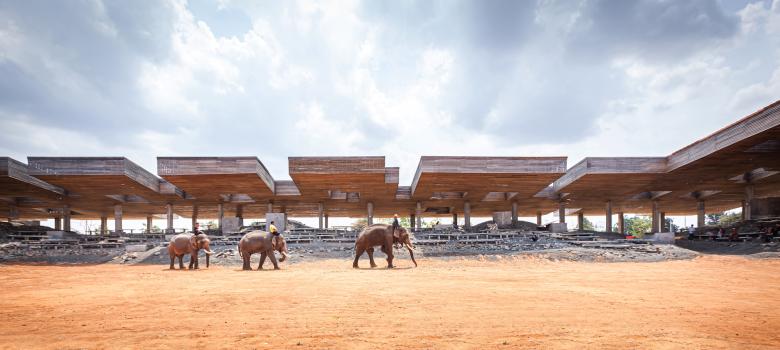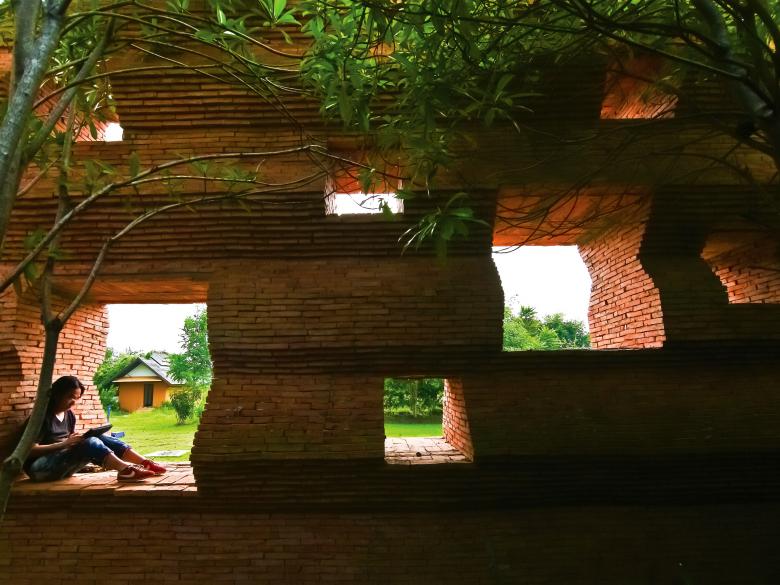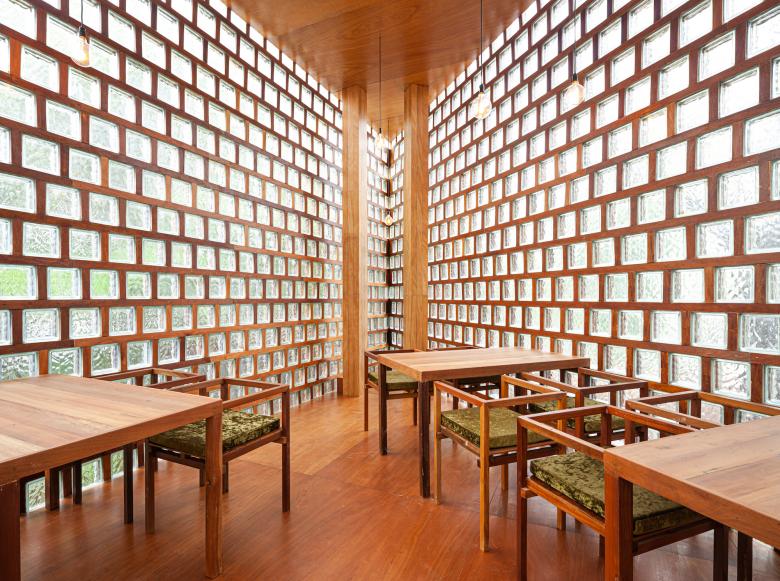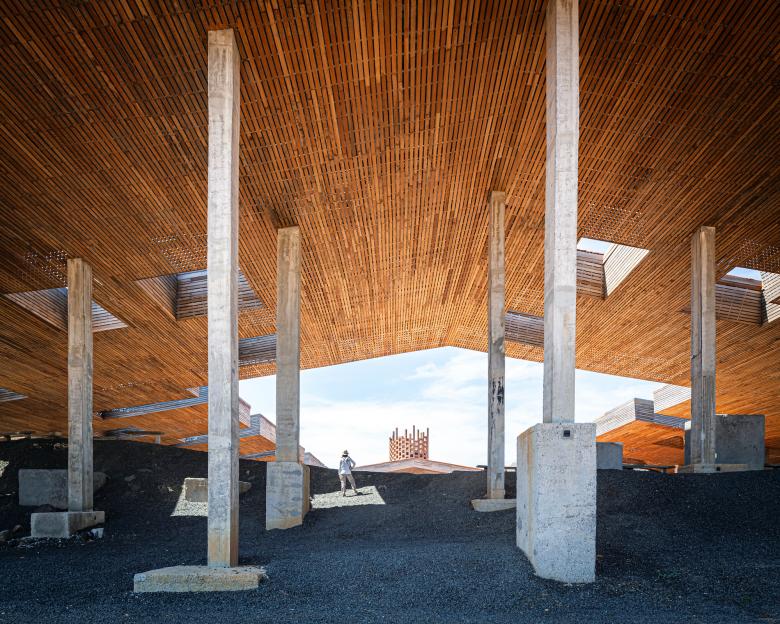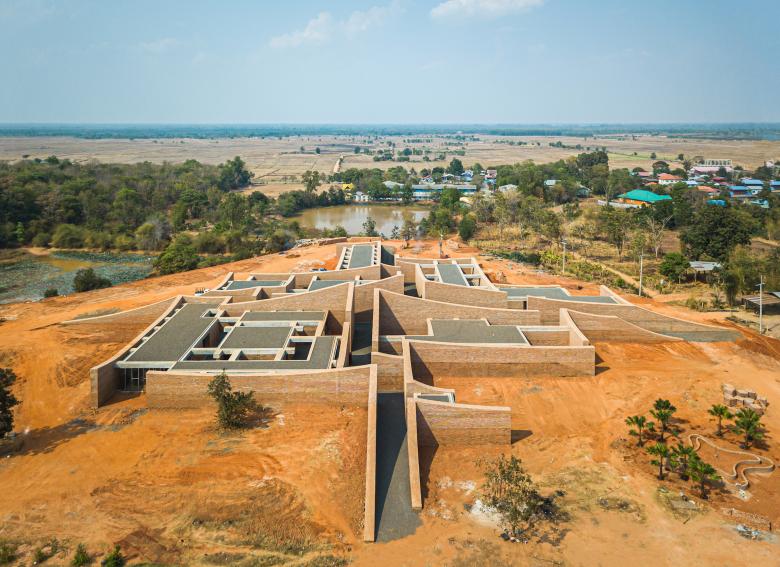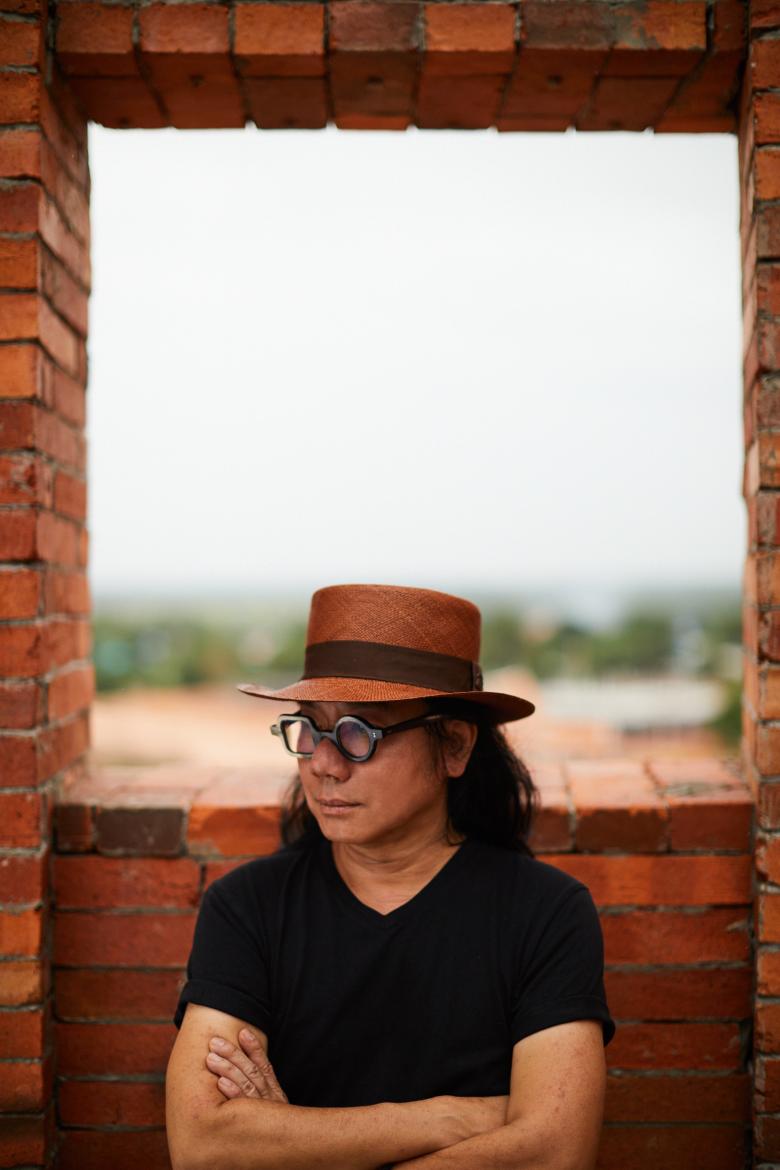2. juin 2022
Bangkok Project Studio, The Cultural Courtyard, Surin Province, Thailand, 2020. (Photo: Spaceshift Studio)
Boonserm Premthada, Thailand’s most interesting architect, argues that “architecture is the physical creation of an atmosphere, serving to heighten our awareness of our natural surroundings.” Premthada revealed other interesting aspects of his unique approach to architecture in his conversation with Ulf Meyer.
Ulf Meyer: In your work, manipulation of light and shadow is important but also are wind, sound, and smell, alongside socio-economic and cultural factors. Some of your projects even include programs to improve equality.
Boonserm Premthada: My work expresses humanness through sensory perception, intuition, and feelings, using architecture as a tool to materialize atmospheres that conveys emotions and help us empathize with other humans and living beings. Most of my works are in rural, almost inaccessible, or unknown areas in order to improve those localities and people’s quality of life instead of focusing only on the prosperity of the city.
For your exhibition at the Royal Institute of British Architects (RIBA), you…
This exhibition showcased the works of the winners of the Architectural Review Award for Emerging Architecture 2011. That year, my Kantana Film Institute, and the work by a Spanish architect were the co-winners. The exhibition took place in the hall of the Royal Institute of British Architects. It recounted the quests for solutions of young architects from around the world. I would like to use architecture as a conduit, to deliver my message about the relationship between man and nature.
Your pavilion “A House for Human and a House for Elephants” represented Thailand at the 2021 Venice Architecture Biennale. How do you design for small humans and big mammals alike?
My intention was to present housing styles of a human’s and elephant’s house in a village of the Kui people, where humans and elephants have been living side by side for centuries. An elephant’s house is a single wooden pole with a corrugated metal sheet as a roof while a human’s house has many wooden poles. These two buildings have different scales depending on the sizes of the users. I designed this pavilion by combining the two separate buildings to depict the coexistence between the two species. All of the wood was from an old house that had been demolished and was transformed into a new single structure supported by the elements from the two houses that could now stand free as one. Unfortunately, we were unable to transport it to Venice due to COVID-19 and logistics, but the curator and I decided to have an Italian contractor build a replica of the pavilion in the exhibition room. The real pavilion was installed on the site of the Kui’s temple for the villagers.
Bangkok Project Studio, School of Brick at Kantana Movie Town, Nakhon Pathom Province, Thailand, 2011. (Photo: Spaceshift Studio)
In your Kantana Institute, you develop a contemporary architecture rooted in the past. The School of Cinematography, in Nakhon Pathom Province, uses handmade bricks to create monumental walls and rooms. It was interpreted as “a symbol of the environment itself, a metaphor for the history and traditions of the place.”
I want to express my view about the situation that the school, and schools in general, are in. Learning to be human is important but often overlooked. Today, the education system focuses on academic excellence and modernity while neglecting the human aspect of the learners. For that reason, the design of the Kantana Institute was founded on the “atmosphere” that evokes feelings in the learners and transforms them into “emotions” that solidify as memories. Brick walls create the sound of silence, dim light, breezes for breathing and inhaling the scent of trees, and the sense of temperature on our skin. These things make us “feel” alive and remind us that we are humans. I look at the work through a perspective of a normal person and design it with my heart.
The project creates pleasant openings, where one can sit inside the brick structure, relax and contemplate, and the spaces act as a filter. Inside and outside cannot be distinguished.
I started from the “purity” of the space and then highlighted it, making it perceivable by human senses. Students need imagination and inspiration, so I created a space for them to spend time. The brick wall is a parallel world, an oxymoron in itself — the undulating wall facing up to the sunlight and creates shadow, the cool summer, the walk in a long narrow forest, the sound of footsteps on the pebbles breaking the silence, the day versus the night, the swaying leaves teasing the sturdiness of the wall.
Bangkok Project Studio, School of Brick at Kantana Movie Town, Nakhon Pathom Province, Thailand, 2011. (Photo: Spaceshift Studio)
At the Woman Restaurant in Ayutthaya there are five triangular buildings made of glass blocks framed by wood. Bordering the bank of the Chao Phraya River, the buildings look sparkling. Each has a different function.
I want to remind people to turn back and look around themselves. Glass blocks and wood are utilized in a new context that enhances their values. The combination of the wall that supports the weight, glass blocks, wood, and steel, together with the triangular shape, makes the building strong. The Artisan Ayutthaya is an effort to overcome a budgetary constraint, a structural challenge, and to pass on knowledge to local workmen who are not artisans.
Bangkok Project Studio, Artisans Ayutthaya: The Woman Restaurant, Amphoe Phra Nakhon Si Ayutthaya, Thailand, 2021. (Photo: Spaceshift Studio)
Most of the residents are unmarried or widowed women. Their daily activity is to give alms to monks in the early morning at a temple. They earn money to repair the temple. Each of them cooks specialties in large pots and pack the food in bags to offer to the monks. These women cook delicious dishes. Part of the income is allocated to the temple’s renovation?
Good work must come from a good initiative. This project was designed in 2017 and the challenge was to understand these elderly women. They remind me of my mother, who did her best in preparing every meal for her children. Stories and lives of the women in villages, the disappearing local cuisine, their time that is running short, the tenderness, the generosity, the faith, and people who stand on their own feet — these are the elements I can never put in words. So, I decided to create the architecture as a backdrop for this village, and honored these women who are cooks, aunts, grandmothers by naming the buildings after them. Sorawee Visitsopa is the owner of the project.
Bangkok Project Studio, Artisans Ayutthaya: The Woman Restaurant, Amphoe Phra Nakhon Si Ayutthaya, Thailand, 2021. (Photo: Spaceshift Studio)
A Kui family includes humans and elephants. A Kui house features space for humans and elephants under the same roof. Kui and their elephants suffered droughts, shortages of food and medicinal plants. The two wandered the streets of tourist towns begging for food. Your Elephant World is a governmental project to bring the Kui and their elephants back to their homeland. The project includes the Kui village, an elephant hospital, temple and even a graveyard for humans and elephants.
The Elephant World is my first project for elephants, the largest land animal. The project is located in an elephant village where people have lived with elephants for over 400 years, and where the beliefs, traditions, and cultures of their ancestors are kept alive. I put a lot of effort to understand the domesticated elephants. It took humility and respect to convince the villagers that I would not alter their livelihood or wrongfully accuse them of animal torture. They have been traumatized by some foreigners who painted them as animal torturers.
The Elephant World aims to illustrate the relationship of the two species, to restore the national reserve forest, to preserve a traditional way of life, and to create a sustainable local economy. From 2015 to the present, I have been welcomed as a member of the community. This project serves to connect, spread goodwill, shed a new light on the community. We have gained attention and support from the public and private sectors.
Aerial of Elephant World in Surin Province, Thailand. with Brick Observation Tower (2020) at right, The Cultural Courtyard (2020) in the center, and Elephant Museum (2020) beyond. (Photo: Spaceshift Studio)
The Cultural Courtyard is a sloping roof that spans a large ground where cultural events and religious ceremonies take place. The 200 elephants living here require thousands of cubic meters of water per month. Your rainwater collection pond was dug to form an amphitheater?
We should not differentiate between what is architecture, interior, landscape, and structure, because everything happens at the same time. In summer, the water shortage is the most severe in the country. So, I dug the ground to make a pond, and the soil obtained was used to build an amphitheater over which I placed a large, thick roof that provides shade. I planted large trees on the slope so that their roots can hold the soil in place, and serve as another layer of shade. The Cultural Courtyard fuses architecture and landscape. Architecture can also create infrastructure.
Bangkok Project Studio, The Cultural Courtyard at Elephant World, Surin Province, Thailand, 2020. (Photo: Spaceshift Studio)
Strengthening the mounds are basalt rocks. When basalt is mined to the groundwater level, the water wells up, forming a reservoir. Your construction of the playground creates another reservoir. With new water sources, moisture has returned to the barren land. Do the Kui care for the trees, maintain water sources and revive the forest?
I make the most of local natural resources and use them efficiently to avoid waste because they take a long time to recover. These natural materials have a natural shape, are durable, and do not require much care. The building will grow older, become more beautiful, and timeless. Once we understand nature, we can design only half of the structure, and leave the rest for nature to step in.
Bangkok Project Studio, The Cultural Courtyard at Elephant World, Surin Province, Thailand, 2020. (Photo: Spaceshift Studio)
The Elephant Museum is designed to accommodate another species with a different scale. While reviving the forest and water source, most Kui earn their living via ecotourism. When the forest returns, elephants roam in the woods, and the Kui and elephants may use the same water source and eat the same food?
This village is an example of “interdependence” between people, animals, and natural resources. Mutual respect lies at the heart of this museum.
Bangkok Project Studio, The Elephant Museum at Elephant World, Surin Province, Thailand, 2020. (Photo: Spaceshift Studio)
The museum portrays the voice of the villagers and 200 elephants living here — of their relationship. Amidst the treeless landscape, curved walls at varying heights sprout from the ground, opening the building up to visitors of an elephant’s size. The walls slope and cross one another; are they revealing gaps that lead visitors inside?
I chose not to put anything in this museum except for the words of the Kui people and their elephants. They have been attacked by foreigners. It’s time that we found a place where they can speak their mind and express the feelings they have for their animals, and let children take turns telling their stories to preserve and pass on the culture from generation to generation. I want to preserve the atmosphere of the place through the color of the bricks made of the clay in the area. This is a living museum with real people and elephants.
Bangkok Project Studio, The Elephant Museum at Elephant World, Surin Province, Thailand, 2020. (Photo: Spaceshift Studio)
Courtyards open up from the four exhibition galleries. Some are filled with pools or reddish earth like the landscape. Different scales of outdoor paths, sheltered space, and courtyards recall elements from elephants, humans, their houses, ponds, to the dirt bath elephants enjoy.
There are the forest courtyard, the soil courtyard, the pond courtyard, and the elephant food courtyard. All these represent natural resources essential for elephants.
Bangkok Project Studio, The Elephant Museum at Elephant World, Surin Province, Thailand, 2020. (Photo: Spaceshift Studio)
Sunlight is an essential element in your design. Rooms and paths are brightly lit or dimmed in others. The effects change throughout the day. Exhibitions may happen in the courtyards or on exterior walls. Inside the galleries, one may only find seats to rest and look out at the content displayed outside. Were the fired clay bricks made by hand?
Yes, from loam found in the area. My exhibition portrays the atmospheric beauty of the Elephant Village, through the sunlight, the soil, the imperfection of the brick walls, the temperature, the sounds of the elephants and their mahouts, the local language, the smell of dung, and the wind that circulates in the building. This atmosphere is unique to the village.
Thank you very much.
